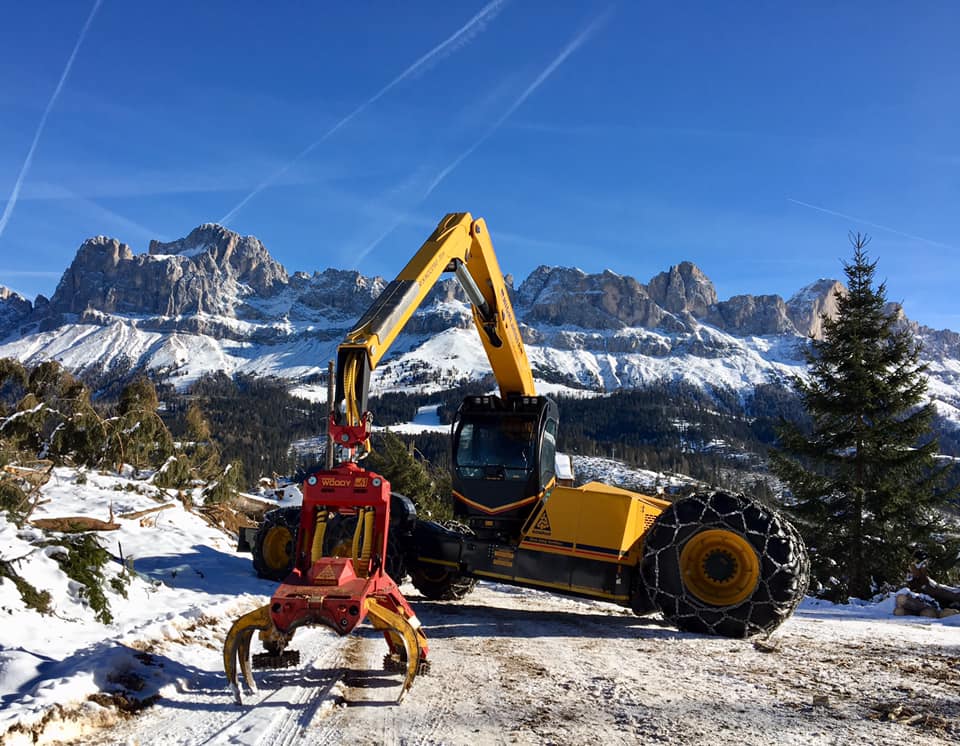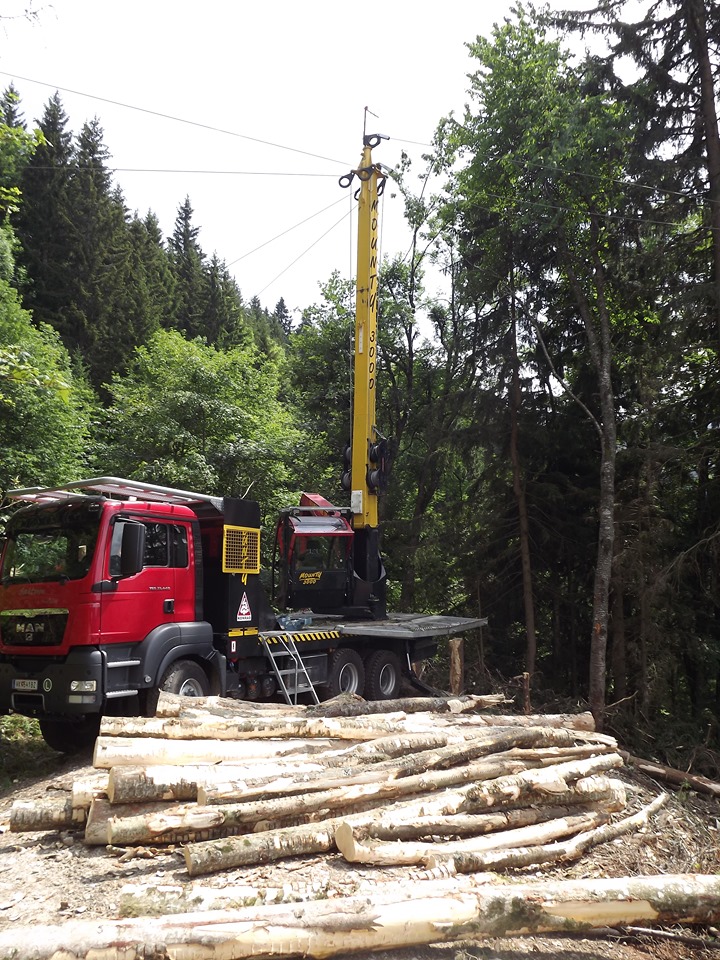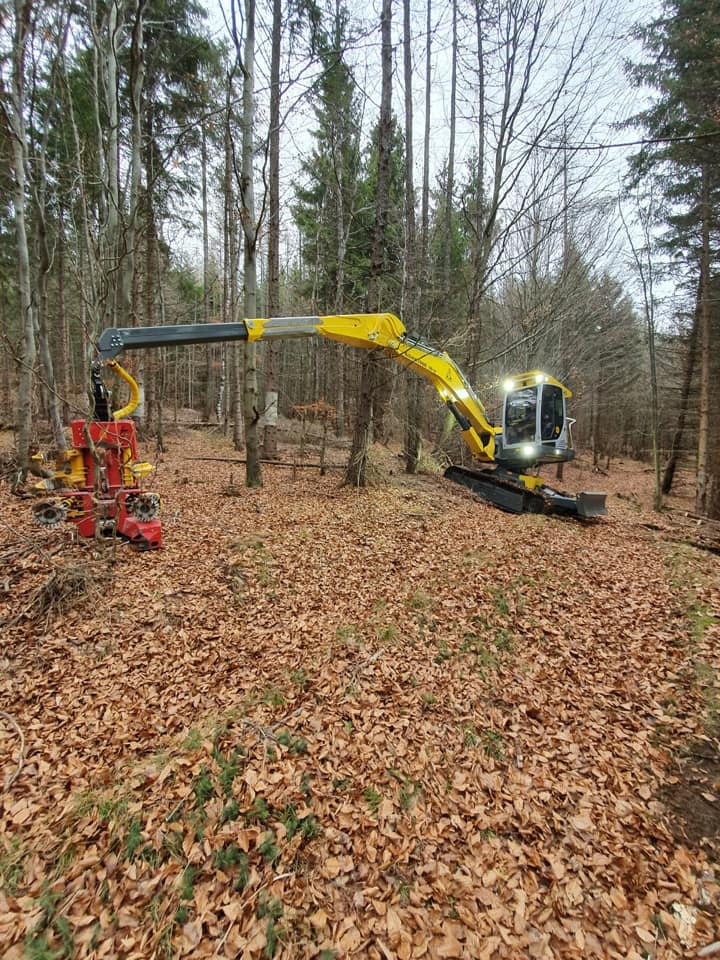Konrad Alpine Logging
Inevitably with the magazine, the lines between holidays and work trips are often blurred. One such holiday saw us touring Germany and Austria on a Honda 600RR motorbike with a stop at Konrad Forsttechnik GmbH. We took the overnight ferry from Hull to Rotterdam and, after travelling down through Germany, we spent a few days in Salzburg in Austria. We had a ride over the Grossglockner High Alpine Road at the heart of the High Tauern National Park before heading south to Konrad’s premises at Preitenegg, which is not far from the Slovenian and Hungarian border.
The journey from Salzburg to Preitenegg was incredible; the weather was glorious and the scenery stunning. The journey took longer than expected as it included many stops for photographs at various sawmills and timber haulier yards that we found en route.
We arrived at the alpine village of Preitenegg late in the afternoon. This picturesque village, 1,076m above sea level and with a population of just under 1,000, is in the Austrian state of Carinthia. There was a shop and two hotels, one of which Franz Buchsbaum, sales manager at Konrad, had arranged for us to stay at.
The following morning Franz first took us on a tour of the factory, which was about 3km away, to see some of the Alpine logging equipment they manufacture and it was a much larger facility than I expected.


The company manufacture various specialised forestry equipment: the Mounty skylines, the Highlander timber harvester, the Woodliner and Liftliner carriages, the KMS compact yarding systems, the Pully timber transporter, and the innovative Woody heads.
Seeing these different products in various stages of production was fascinating and Franz was an excellent guide with a wealth of knowledge about the company and their products.
Konrad was founded in 1990 by Josef Konrad, who had previously been a workshop manager for a large forestry company maintaining their machines. He purchased the premises in Preitenegg and started out with four employees manufacturing their own equipment. First off the new production line was the Woody processing head.


Josef understood that logging was a high-risk occupation with the highest accident rate of any profession with 24-30 fatalities per 100,000 each year in Europe. Mechanised harvesting has helped to minimise the risk but it is still limited to slopes of around 30°. Many forests are grown on slopes steeper than 30° which have to be harvested manually and this puts operators at risk and is far less productive. Josef was focused on developing mechanised harvesting equipment that would meet those criteria.
After our tour of the workshops we visited the research and development department. This area is the heart and soul of the company where new ideas and techniques are born – 7% of the company’s turnover goes back into this department. Konrad were the first company to successfully manufacture a continuous rotator for working alongside a harvesting head.
After our tour of the inside of the factory and offices, Franz took us to the outside yard where some equipment was almost ready for delivery to customers and other products were in for servicing. I saw two four-wheel drive Highlander harvesters with Clam bunks and Woody 60 harvesting heads. It is only when you get close to these machines that it becomes clear just how much technology and forethought has gone into the design. Franz had an operator from the factory demonstrate the Highlander ascending and descending a steep mound in the yard and it was impressive to watch.
The Highlanders are available in both 4WD and 6WD. Both versions use the Iveco Tier 4 six-cylinder 285hp engine and are available with a Woody 50 or 60 harvesting head. There are two crane lengths – the 4WD has a 10m reach while the 6WD a 10.5m reach – and vision is superb as the crane is mounted to the rear of the cabin.


The cabin is spacious and has a levelling system with continuous cabin and crane rotation.
The 4WD has front and rear steering so it is able to crab sideways and has a tight turning circle. The rear wheels extend out of a box chassis for extra length and each wheel can be raised or lowered for keeping the harvester level and better stability. The 6WD has the addition of articulated steering with bogie functioning portal tandem axles.
Both of these models are available with a built-in traction winch with 300m of cable.
Joseph wanted a machine that was stable and capable of safely working on extreme slopes. His intention was to develop a machine to fell the trees in steep conditions and then load them into the clam bunk for extracting to the roadside. Once there, the trees could be processed and stacked ready for delivery to the sawmill using the same machine. Josef achieved this with the Highlander and they can be seen in use in many countries around the world, including the UK.
Further along the yard was a new Mounty 4000 skyline mounted on a MAN TGS 41.440, undergoing some final touches before being delivered to its new owners Tritscher Forstbetreib.
Franz suggested that we head off for some lunch and he had arranged an afternoon visit to see a Mounty 3000 skyline with a Woody 50 head working about an hour away.
The skyline was working at high altitude up the side of a mountain; I thought some of our forest roads were narrow, but these roads were even worse. Franz was happily chatting away, looking at me as he was driving along – the driver’s side was against the hill and from the passenger’s side window I was looking out over a vast drop only slightly hidden by the trees. Franz was asking questions about forestry in Scotland but I was struggling to answer as my lips were glued together in sheer terror!
As we approached the harvesting site a few thousand metres above sea level, there was a truck next to the skyline loading timber with no room to pass. Franz thought he had seen a wider section on the road about half a mile back and started reversing – if I thought driving up was scary then hurtling downhill in reverse with the car in neutral gave fear a whole new meaning.
We found the not so narrow bit that Franz had seen, left the car there and started walking up towards the skyline. I have to take my hat off to the truck drivers that are hauling wood from sites like this; they really are a special breed and supply sawmills with timber summer and winter no matter what the weather.
The Woody 3000 skyline belonging to Saltum Forst was mounted on a MAN TGS 33.44D and was parked in the middle of the road and extracting the wood uphill. The wood was being cut by chainsaw operators so far down the hill they were out of sight, and I reckon the slope was in excess of 50°. This job must have been a chainsaw operator’s nightmare as it is far better to walk uphill first thing in the morning when your energy levels are high and downhill at finishing time when you are knackered. This job was the opposite.


The Mounty skylines have a brilliantly thought out design which allows the crane and cabin to fully rotate around the base of the skyline tower, ensuring crane access to both sides and the rear of the truck. From the cabin of this Mounty the operator is able to control the skyline carriage, unhook the automatic chokers, process the timber, and stack it for the timber haulier.
Two carriages are available: the Woodliner, which is a self-propelled carriage, and the Liftliner, which is a drawn carriage. Both have integrated winches so that loads can be lifted or lowered and the carriage can move on the skyline.
The head used for processing the timber during my visit was the Woody 50. Konrad manufacture five sizes of harvesting heads – 40, 50, 60, 61 and 70 – for harvesting all sizes of trees up to a maximum diameter of 75cm.
Although it can be used as a conventional harvesting head, the Woody head has been specifically developed for working alongside skyline equipment. It is a unique design as the feed rollers can be folded out of the way and the reinforced de-limbing knives can be used as grapples, either for picking out single trees for processing and for stacking timber/loading trucks. The continuous rotator is invaluable when carrying out this type of work and the unique and patented geometry of the Woody framework also enables the processing of broadleaf trees and crooked timber. The tapered feed rollers provide excellent grip and keep the stems tight against the chassis. Konrad have also created their own Machine Control System (MCS 3.0 used on throughout the Woody range).
When processing, these machines are certainly no slouch as the feeding speed is up to 5m/sec and a top saw is available on some models. To date, no one has come up with a better designed harvesting head as many skyline manufacturers are selling equipment complete with the Woody heads.
We spent a few hours at the skyline site and it was fascinating to see just how effective it was as this is an area of timber harvesting in which I have limited experience. I have worked twice with skylines, once with a Forestry Commission Chapel Hall Leyland skyline in the 1980’s and once in the 1990’s with an Austrian built Syncrofalke mounted onto a MAN truck, and I’ve also seen demonstrations of others, but the Mounty is the most productive setup I had seen. Franz explained that they manufacture three versions of the Mounty, the 3000, 4000 and 5,000 models.
All three models are designed for up and downhill extraction, with a mainline distance of up to 700m for the 3,000 and 800m for the 4,000 and 5,000 models. They all have a 9.1m reach crane fitted with internal hydraulic hoses.
Konrad offer a single warranty on the complete Mounty unit so that customers do not have to deal with any third parties, and all the spare parts are available direct from Konrad. In addition, the company manufacture the KMS skyline, which is a trailer version of the skyline yet still retains the capacity to pull four tonnes.
Something I noticed throughout the day was that Franz’s phone hardly ever stopped. He received calls from all over the world for sales enquiries and from customers with technical problems. Franz was able to get the information from customers over the phone that would give him the information to diagnose the problem so he could offer a solution. One of the calls required the customer to reboot the computer system, but he had been trying himself prior to speaking to Franz and couldn’t get it to work. Franz explained that a little patience was required so that the system could be reconfigured before attempting to restart it. The customer was quite irate on the phone to begin with and the language barrier didn’t help. He was from South America and the conversation was in English as it was a lingua franca for them both and the customer was struggling to explain some of technical terms. I admired Franz’s cool and calm manner in dealing with the customer – he was able to explain what was required to get him going again and the customer finished the call extremely happy with a working machine.
We returned to Konrad’s premises that evening having spent an amazing day with Franz. Since our visit, we have met up on numerous occasions both overseas and in the UK and have developed a good friendship.
At Euroforest in France in 2018, we saw the latest innovation from Konrad: the excavator-based tower yarder. Two models are in production: a thinning version with a Woody 40 head and a larger one with a Woody 60 head. The tower setup takes place automatically and the excavator rotates around the tower base. A full report on these tower yarders is included in issue 20 of our magazine.


Last October, I met Franz at the Austrofoma forestry show in Austria and the company had another new innovation on display which caught my eye: a 12-tonne ET 90 Wacker Neuson which has been converted into a KDH 40 Harvester. This machine is equipped with a 75hp Deutz four-cylinder turbo diesel direct injection engine, the cabin has been altered and will tilt 22° forward, and the company have fitted their own extending dipper boom which has increased the reach to 9.3m.
This is a low impact thinning harvester which will work well on soft and steep conditions. Konrad have fitted their own joysticks and replaced the front window with 15mm thick Lexan polycarbonate thermo plastic. Finally, a Woody 40 head has been fitted which is capable of harvesting timber up to 45cm in diameter. As the machine is 2.25m wide, it is capable of thinning in tightly grown timber; a remote control winch can be fitted to the main boom for trees that are out of reach. It looks a very capable and well thought out machine and one that would work well in the UK.


Konrad have recently introduced a new skyline carriage, the E-liner. This is a slag pulling carriage powered by an electric motor-generator – hauling in charges the energy, which is used for paying out the cable. A new Highlander basic machine is also available from Konrad. This is a light version of the Highlander without the cabin tilt and wheel extensions.
Today, Konrad is run by Josef’s son Markus, who took over in 2015. They have a workforce of 115 and manufacture between 250 and 280 machines each year. The main market is still Austria, but Konrad is present in many of the European countries that require forestry equipment. They are also popular in Japan, Korea, New Zealand, Russia, Chile and Brazil. Around 60% of the equipment manufactured is exported. www.forsttechnik.at
Forest Machine Magazine is written and edited by a forest professional with over 40 years hands on experience. We are dedicated to keeping you informed with all the latest news, views and reviews from our industry.
To support us you can subscribe to our bi-monthly magazine which is delivered to your door from only £30 per year.
Subscribe here

